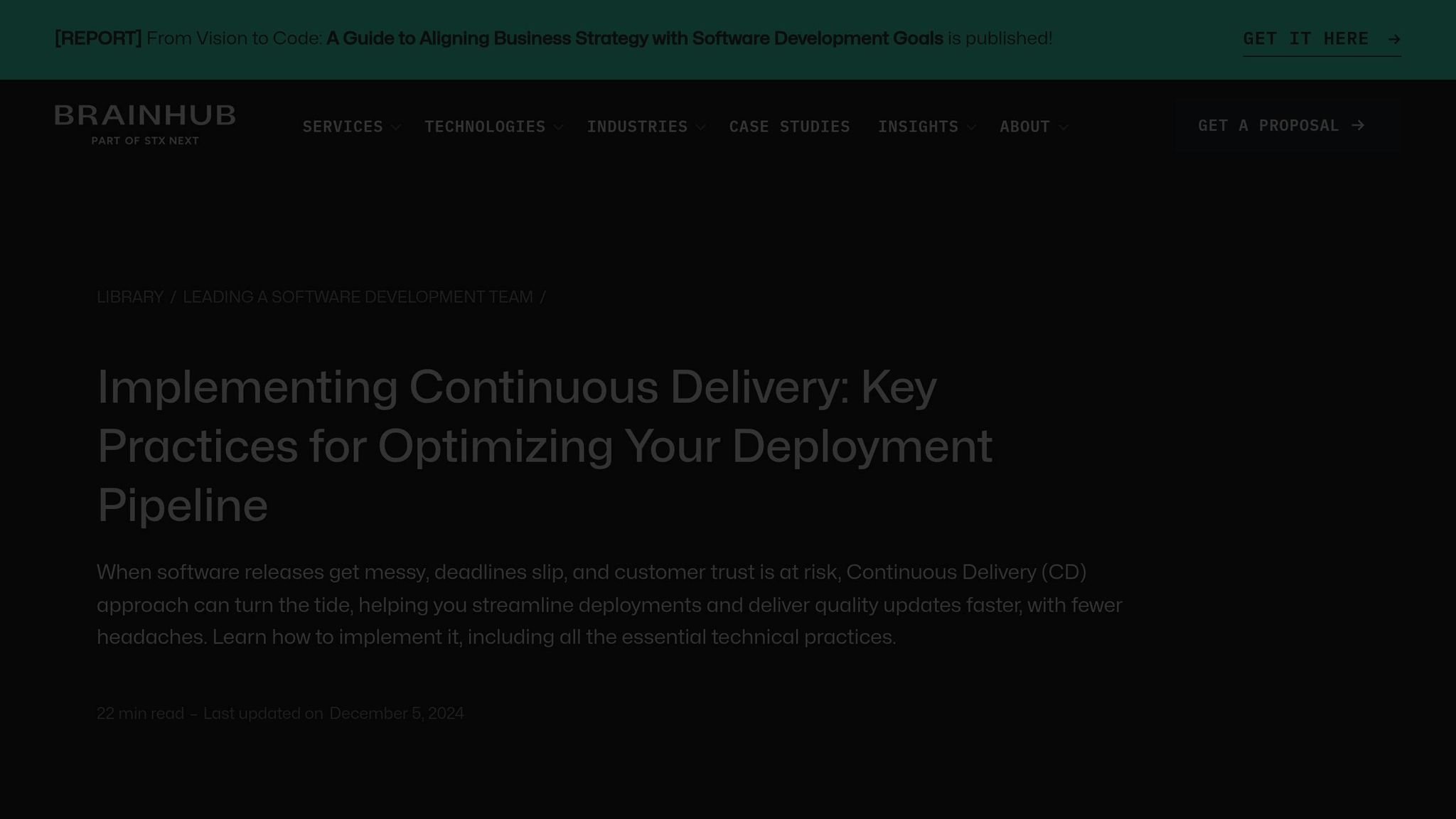Every secure and efficient DevOps deployment requires a smart rollback plan that includes a mix of automated tools, manual processes, and expert-led frameworks. Be sure to tailor your strategy to your business needs, focusing on security, cost, and performance.
- Manual Rollback Procedure: Requires teamwork and careful checks. Steps include pre-rollout assessment, team coordination, verification, and thorough documentation.
- Automated Rollback System: Fast and efficient, these systems monitor key metrics and revert changes automatically when issues arise. Key components include health checks, threshold triggers, and version control integration.
- Hybrid Rollback Framework: Combines automation with expert oversight, reducing downtime, improving security, and saving costs (up to $200,000 annually).
Quick Rollback Plans Comparison:
| Criteria | Automated Rollbacks | Manual Rollbacks | Hybrid Framework |
|---|---|---|---|
| Speed | Fast | Slow | Moderate |
| Reliability | High (but limited in edge cases) | Moderate (prone to errors) | High (with expert input) |
| Cost | High initial setup | Ongoing training costs | Balanced |
| Performance Under Load | Good | Moderate | Excellent |
| Security | Needs validation | Error-prone | Strong (built-in checks) |
Recreate vs. Rollout: The Best Deployment Strategies Explained
1. Manual Rollback Plan
Automated rollbacks are quick, but sometimes they fail or need human intervention. That’s where manual rollback procedures come in. These steps require teamwork and careful checks to ensure the system stays secure and stable. Here’s a breakdown of the manual rollback process:
- Pre-Rollback Assessment
Before starting, review and document the system’s current state. This includes checking database consistency, tracking active user sessions, and noting any pending transactions. - Team Coordination Protocol
Clear communication is key. Assign specific roles to the following teams:- Development Team: Prepares rollback scripts and ensures code compatibility.
- Operations Team: Executes rollback commands and keeps an eye on system health.
- Security Team: Monitors and confirms all security measures remain active.
- Verification Steps
Each stage of the rollback should be carefully checked. Use this framework:
Stage Checks Criteria Pre-rollback System health metrics, active sessions All metrics within normal range During rollback Database consistency, service availability No data corruption; minimal downtime Post-rollback Security controls, application functionality Security measures active; core features working - Documentation and Recovery
Keep detailed logs, including timestamps, commands used, team roles, and verification results. After completing the rollback, run thorough system health checks. Confirm all security measures and critical functions are working properly, and monitor performance. Document everything to improve future processes.
Technology leaders at CTOx emphasize the importance of the first 90 days for setting up solid rollback procedures. During this time, teams should audit existing systems, address issues quickly, and look for ways to improve processes.
Next, we’ll discuss the automated rollback procedures to compare automation with the hands-on approach.
2. Automated Rollback Plan
Automated rollback systems help ensure safer deployments by quickly reverting changes when problems arise. These systems constantly monitor key metrics and automatically roll back updates if certain thresholds are crossed.
Here’s what makes an automated rollback system work effectively:
- Health Checks: Continuous tracking of metrics like API response times and error rates.
- Threshold Triggers: Predefined conditions that automatically start a rollback.
- Version Control Integration: Smooth connections with version control tools to switch back to a stable release.
Compared to manual rollback, automated systems respond faster, cutting downtime and improving Mean Time to Recovery (MTTR).
To implement an automated rollback system, focus on these three areas:
- System Architecture
Build architectures that allow seamless rollbacks for databases, APIs, and front-end components. - Monitoring Infrastructure
Set up strong monitoring tools to track performance metrics, infrastructure stability, security, and user experience. - Error Handling Protocols
Develop error-handling processes to avoid false alarms, manage partial rollbacks, fix dependency issues, and protect data integrity.
Strong technical leadership is essential for choosing the right tools, setting up rollback triggers, and defining effective monitoring. Automated rollback systems play a key role in keeping deployments secure, improving efficiency, and reducing downtime.
sbb-itb-4abdf47
3. Hybrid Rollback Framework
The Hybrid Rollback Framework is designed to reduce downtime by combining proactive monitoring with regular system updates. These elements set it apart from more traditional rollback methods.
Key Components
Here’s what makes the hybrid framework effective:
- System Health Monitoring
The process includes using detailed KPI scorecards to track system performance at every stage – before, during, and after rollbacks. This provides clear data for quick, informed decisions. - Response Protocol
A fractional CTO leads the rollback process, addressing issues quickly while maintaining strict security standards. - Cost Savings
By streamlining decision-making and automating monitoring, this framework can save companies over $200,000 annually compared to systems managed by full-time CTOs. - Ongoing Updates
Every 90 days, audits are conducted to pinpoint vulnerabilities specific to this framework. These audits help improve response times, bolster security, and strengthen overall system reliability.
Comparing the Impacts of Rollback Plans
This section takes a closer look at key factors to consider when comparing rollback methods in secure deployments. These factors include speed of implementation, resource needs, reliability, cost, performance under load, and security. We’ll examine three approaches: automated systems, manual procedures, and the Hybrid Rollback Framework, which combines automated monitoring with expert oversight.
Implementation Time and Resource Requirements
Automated systems allow for quick rollbacks with minimal manual involvement. On the other hand, manual procedures take more time and require larger teams. The Hybrid Rollback Framework simplifies the process by blending automation with expert input, reducing both time and resources needed.
Success Rate and Reliability
Manual procedures often face challenges, as they rely heavily on human coordination, leading to potential errors. Automated systems tend to deliver more consistent results but can struggle with unexpected scenarios. The Hybrid Rollback Framework improves reliability by pairing automated processes with real-time expert monitoring, making it especially effective in critical deployments.
Cost Factors
Costs differ widely across these methods. Automated systems involve high initial setup expenses, while manual methods require ongoing costs for training and documentation. The Hybrid Rollback Framework strikes a balance, combining upfront investment with lower long-term monitoring expenses.
Performance Under Load
Manual and automated methods generally perform well under light user loads. However, as demand increases, maintaining consistent performance becomes tougher. Automated systems and the Hybrid Framework handle higher loads more effectively, with the Hybrid Framework excelling in recovery during peak usage.
Security Considerations
Security is a top priority during rollbacks. For that reason, automated systems need rigorous validation to avoid vulnerabilities. Manual methods are more prone to errors, especially during rushed rollbacks. The Hybrid Rollback Framework includes built-in security checkpoints, ensuring sensitive data stays protected while maintaining strict safeguards throughout the process.
Conclusion
In summary, choosing the right rollback plan is key to ensuring secure and reliable deployments. A well-rounded strategy that incorporates automated systems, manual processes, and expert oversight can provide tailored benefits based on an organization’s specific needs and resources, for instance.
Additionally, collaborating with experienced technology leaders can simplify rollback procedures. For example, as CTOx explains, "A fractional Chief Technology Officer (CTO), or Part-Time CTO, serves as your go-to executive tech leader, at a fraction of the cost and time – often saving over $200,000 per year. They direct your technology strategy and manage your tech department without the full-time CTO hassles."
Above all, a rollback strategy should align with business goals. Fortunately, Fractional CTOs offer the expertise needed to guide this alignment, delivering strategic insights without the expense of a full-time hire. They connect technical execution with broader business objectives, ensuring that rollback procedures are both secure and efficient.
Finally, when planning rollback strategies, businesses should focus on these key areas:
- Security and Data Protection: Safeguard data integrity and follow established security protocols during rollbacks.
- Resource Optimization: Balance automated tools and manual efforts to match available resources.
- Performance Management: Monitor system performance during rollbacks to reduce downtime.
- Cost-Effectiveness: Consider both immediate setup costs and long-term maintenance expenses.
As you know, the Hybrid Rollback Framework combines automated monitoring with expert oversight to address these priorities. This approach helps businesses achieve technical efficiency while retaining the human expertise necessary for handling complex deployment scenarios. The result? A smoother, more secure deployment process that aligns with operational and business objectives.








